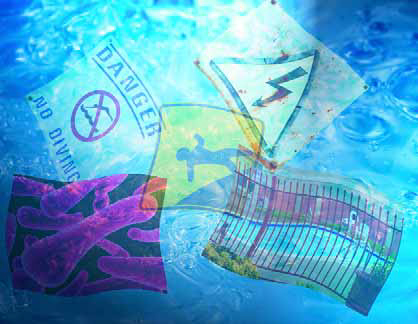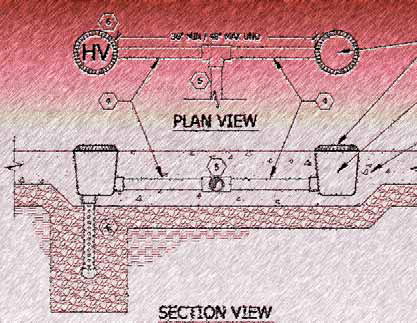suction entrapment
The death in 2002 of the granddaughter of former U.S. Secretary of State James Baker brought the problem of suction entrapment to unprecedented public attention. That incident - and others in which bathers have become stuck atop pool drains - have led to development of new legislation and pool-construction standards as well as increased awareness of the hazard. To me and some others, however, the new rules represent a reactive, regulatory solution to what might better be approached as a proactive matter of technology and engineering. In stepping back and carefully examining the anatomy of these terrible accidents, it becomes clear that, although steps can be taken to reduce risks, there is no single approach, given current design and construction practices, that will eliminate risks altogether. So far, in fact, all of the industry education and media attention we've witnessed is focused on solutions that at best mitigate entrapment hazards but do not eliminate them. These are not, unfortunately, approaches that lead us to complete and effective solutions. As an industry, we have not grappled with what I see as the true, addressable core of the issue
The death in 2002 of the granddaughter of former U.S. Secretary of State James Baker brought the problem of suction entrapment to unprecedented public attention. That incident - and others in which bathers have become stuck atop pool drains - have led to development of new legislation and pool-construction standards as well as increased awareness of the hazard. To me and some others, however, the new rules represent a reactive, regulatory solution to what might better be approached as a proactive matter of technology and engineering. In stepping back and carefully examining the anatomy of these terrible accidents, it becomes clear that, although steps can be taken to reduce risks, there is no single approach, given current design and construction practices, that will eliminate risks altogether. So far, in fact, all of the industry education and media attention we've witnessed is focused on solutions that at best mitigate entrapment hazards but do not eliminate them. These are not, unfortunately, approaches that lead us to complete and effective solutions. As an industry, we have not grappled with what I see as the true, addressable core of the issue
The death in 2002 of the granddaughter of former U.S. Secretary of State James Baker brought the problem of suction entrapment to unprecedented public attention. That incident - and others in which bathers have become stuck atop pool drains - have led to development of new legislation and pool-construction standards as well as increased awareness of the hazard. To me and some others, however, the new rules represent a reactive, regulatory solution to what might better be approached as a proactive matter of technology and engineering. In stepping back and carefully examining the anatomy of these terrible accidents, it becomes clear that, although steps can be taken to reduce risks, there is no single approach, given current design and construction practices, that will eliminate risks altogether. So far, in fact, all of the industry education and media attention we've witnessed is focused on solutions that at best mitigate entrapment hazards but do not eliminate them. These are not, unfortunately, approaches that lead us to complete and effective solutions. As an industry, we have not grappled with what I see as the true, addressable core of the issue
I hadn't planned on breaking away from my coverage of the National CAD Standard anytime soon, but recent events - including the arrest of a pool builder on charges of manslaughter in a suction-entrapment incident - compelled me to do otherwise. As I started composing this column, my plan was to call it "Entrapment Rundown" and make it a straightforward, positive summary of recent changes in codes and systems related to suction entrapment. As I dug more deeply into the topic, however, I found the issues and solutions to be much more confusing than I'd anticipated - so much so that
I hadn't planned on breaking away from my coverage of the National CAD Standard anytime soon, but recent events - including the arrest of a pool builder on charges of manslaughter in a suction-entrapment incident - compelled me to do otherwise. As I started composing this column, my plan was to call it "Entrapment Rundown" and make it a straightforward, positive summary of recent changes in codes and systems related to suction entrapment. As I dug more deeply into the topic, however, I found the issues and solutions to be much more confusing than I'd anticipated - so much so that
It's common knowledge that getting into any body of water - large, small, natural, man-made - involves a certain level of risk. Despite all the healthful benefits of water recreation, despite all of the immense psychological and even spiritual appeal of even being in water's presence, the brutal truth is that, in certain conditions, simply
It's common knowledge that getting into any body of water - large, small, natural, man-made - involves a certain level of risk. Despite all the healthful benefits of water recreation, despite all of the immense psychological and even spiritual appeal of even being in water's presence, the brutal truth is that, in certain conditions, simply
It's one of the most horrific things that can happen to anyone who enters a pool or a spa: One moment you're having fun or relaxing, and in a terrible instant you're caught in a devastatingly painful and potentially fatal situation. Most people who become entrapped by pool, spa or wading-pool plumbing do survive, but all too often they suffer life-altering injuries. As with any aquatic safety issue, we all agree these incidents should be prevented, and a great many talented people from government, trade associations, research institutions, equipment manufacturers and consumer-safety groups have invested a tremendous amount of time in examining suction entrapment. For all of that effort, however, seeing our way to


















The Ultimate Solution for Suction Entrapment